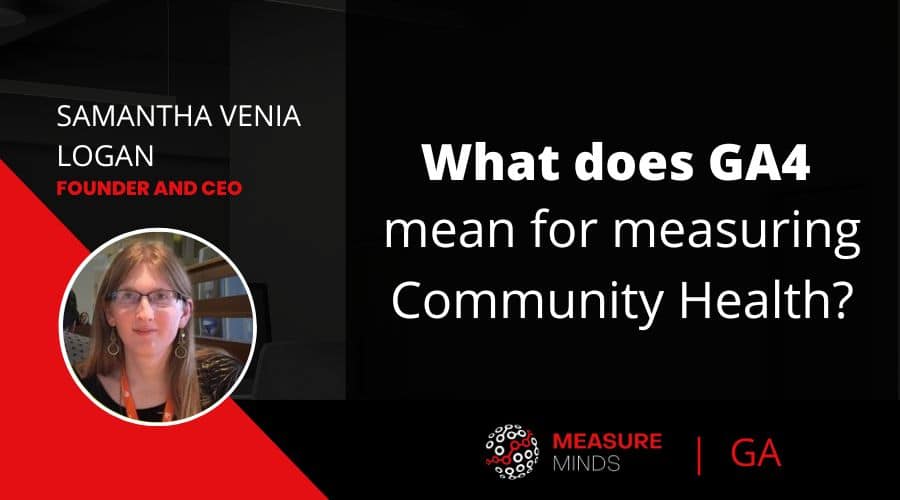
What Does GA4 Mean for Measuring Community Health?
As you’ve probably heard, we’re reaching the end of Universal Analytics (UGA). On July first, Google is sunsetting the previous version of Google Analytics (GA). This means that all data will stop processing in your GA account. But that’s also not the most looming deadline…


Starting in March, a transfer process created by Google will begin moving your data from UA to GA4. Google is effectively forcing you to move to the newest version of GA.
So if you have to Build GA4 anyway, let’s take today to explore what GA4 means for measuring online community.
Webinar write-up
This is a write-up of Samantha ‘Venia’ Logan’s webinar she gave at MeasureMinds’ Digital Analytics Meetup. You can find a link to her slides here. You can also find the recording of her webinar here:
And did you know there’s a part 2?!
This webinar was all about helping marketers measure community. In part 2 we’ll flip the conversation: How can community Managers interface with your team? And we need your voice in that discussion!
Register with the CLG campus to join us on March 1st to “sort out your community data firehose”!
Here’s a bit about Venia:
My name is Samantha ‘Venia’ Logan, I do go by Venia. I love building robust online communities and geeking out about the theories, frameworks, and strategies for doing so! Talkin’ measurement is fun for me, but I’m HORRIBLE at math. I build the dashboards, so I don’t need to do the arithmetic.
Taking advantage of my unique social-scientific perspective on community, I’ve built SociallyConstructed.Online, a consultancy and eCourse business that helps companies build strong community strategies, place community managers, and level up those community managers’ skills by using an iterative community framework.
The three steps to learning GA4


Borrowing the words of measurement marketer Chris Mercer, we need to know GA4 in three main steps.
First and foremost, you need to plan big. This means understanding exactly what your community’s measurable ecosystem is going to be. What precedents are you looking to set? How will you build momentum in your business or online community? Take some time to think about community touchpoints, and the conversations you need to have.
But, do yourself a favour. People fail at strategy because they plan big, assuming everything will stay the same. They then run into a small problem and their strategy fails. Instead, progress small. Take time with each section of your planning. As soon as you run into a problem, ask yourself ‘how can I test this?’
After all, mistakes make better plans
In other words, what progress can you make on your strategy to intentionally make a mistake and learn more?. This will help you to get good and then get better.
Just make sure you take this process one thing at a time.
Why do we need Google Analytics 4?
At this point, you might be asking, ‘why do we need Google Analytics 4?’. If you’re a marketer, you probably recognize that we currently operate with an older system.
Originally,UA was a revision of a platform that began at the start of the measurement era. We were operating on a car that got a decent upgrade, but has since taken too much time and effort to keep it running.
Let’s think about how marketing has worked on UA for the past decade.


We began with the marketing funnel. This was a one-on-one conversation between the user and us.
- This began when a user raised their hand and said ‘I might be interested in this’.
- We then said ‘Great! Just perform this action and we can get started’. This might have meant a user subscribing to a mailing list, or filling out a contact form.
- Once an action was complete, a flag was triggered, and an ad was sent to a user.
- A user was sent a reward, and based on their response, we gathered information about them.
This leads us to the second part of the conversation. Once a tag was added, it would produce or ‘proc’ a second flag. Based on the resulting tags, we could begin to understand the value journey across our net systems. This helped us to understand where in the funnel a customer was.
If, after a certain point in time, a user said ‘no’ we could remove a tag. A user could then be moved to a different point in the funnel. This was how Facebook advertising, Google Analytics, and the retarget marketing era moved. The UGA system didn’t initially understand this but tried to evolve to support it.
Here’s the problem with traditional marketing funnels
Now we live in a world where funnels struggle to cover the entire journey.


Instead, we end up with something like this. A user would enter a funnel, fallout, and come back in again at nonsensical times. Not only was this annoying for users, but it was too complicated for marketers to build systems based on missing “tags”.
The funnel was one of the greatest inventions to come to digital marketing. It still is. But it is insufficient for engaging with our communities at scale.
Why? Because funnels only converse with an individual user. The audiences that have been built into our brand also became our advocates. At this point, we’re not developing a single conversation anymore but a community of people talking to other people.
Here’s how the internet really behaves


It looks a bit like this, the ‘Orbit Model’. In online community management, we look at an entire community of people. And those people engage with multiple funnels across our community.
If you look at the bottom right of the image, you’ll see a highlighted section. That is the traditional funnel. This was always a one-on-one conversation that asked, ‘would you like to get closer to our brand?’. But as you can see, there is a myriad of conversations happening outside that funnel.
We had produced funnel after funnel, whilst ignoring all the conversations outside of it. In reality, we should measure things as a valence model or what we in Social Science call ‘scopes’. These are composed of a series of ‘membranes’ that begin with observers in your community. They decide to take a step and fall into any one of our funnels. That funnel navigates their transition from observer to user.
Often, a user wants to stay in the observer shell for a while. They want to increase their reach and talk to other individuals. After some time, they will make the choice to come closer. That’s when they fall into any other funnel. In this same way, they move from a user, to a fan, to an ambassador. Critically, as ambassadors, they can and should be still engage in the observer shell, the user shell, and the fan shell.
The reason our funnels are annoying on one end and complicated on the other is because our users keep falling into all of our funnels, but they don’t necessarily need them at their stage.
And that brings us to the community managers’ frustration with marketing….
Communities need to quantify value
In order for us to manage the system, we need to quantify the value of our community. The issue is that communities cannot quantify their value outside the funnel. This is because, for the past decade, we haven’t had the ability to measure it.

We have to measure community interactions as well as funnels. If we don’t, we won’t understand the value of the communities that we’ve built.
There are two halves to this problem
We have two issues here. On one end, digital marketers are saying that the funnel is the easiest way to understand the customer value journey. On the other end, community managers are saying that funnels are too restrictive.


In the most recent Orbit constellation report, there were a few findings to help identify the problem.
- Any typical community is active across six different platforms.
- Community teams are trying three new tools and platforms each year.
- Both marketing and community teams lack integration between their tools and data.
It’s because of these issues that multi-platform measurement came about. Community managers now have entirely new tools marketers haven’t been involved with.


The image above shows the major players in the community space. How many are new to you as of this moment? See the issue?
There are two haves to the solution
Marketers need to talk about measurement as a department. This means having a bird’s-eye view of our funnels so we can keep up with people. But to achieve this, marketers need to expand their measurement behaviours.
On the other side of that conversation, community managers have known this for a while. But they’ve not systematised a solution to measuring online communities.
So, marketing and community management have been clashing. The talk below will help in solving this issue.


https://clgcampus.base.ai/event/working-with-community-data-to-create-an-impactful-dashboard/
How does this relate to GA4?
Google Analytics 4 is the marketer’s side of this conversation. This is front-end data analytics. What behaviours and actions are occurring on our websites? What does this say about the larger community that we’re involved in?
We know that there is a conflicting understanding of how people use the internet, how people connect with brands, and how the funnel fits into that model. Google knows this, and UA did not have the capabilities to use the internet as people actually do.
Where UA measured a brand’s expectation, GA4 asks, “How can we get automatic feedback on user action, to optimize the transition between community scopes?
What can you do in GA4?
GA4 looks at the internet as it stands; as a collection of culture and communities. It’s changing its measurement methods to fit with this. This means that you have to understand the new data approach and modify your strategy to fit your users’ expectations.
So, what is the new method? Firstly, we must recognize that the internet is a collection of cultures. Cultures and communities are social-scientific. We cannot measure them unless we understand the social scientific process.
Let’s go back to sixth grade when you learnt the scientific method. This is an incredibly robust process for understanding individual pieces of a topic. But the scientific method was insufficient for us to study online cultures.
Socially scientifically, we view communities very differently. Take the definition of community.


The data scientists reading or watching will probably look at this and say, “We can just apply a metric to each of these factors then Voila”.
And you’d be correct. But there are some complexities involved.


The social scientific process changed the scientific method in 4 ways so it works outside of a ‘lab scenario’. This created an equally robust and logical alternative. These changes also make measuring communities easier.
First and foremost is benchmarking.
The process needed to work in the long term. We have to consider one long experiment that includes variables. These variables, however, could not be the focus.
Second, variables are not the focus of experimentation
You could have the exact same variables applied in the exact same circumstances in two different audiences, but the audiences will break it. The variables aren’t the problem, it’s the ‘scope’. So we choose variables to study but keep them the same.
Instead, we change the scope
By keeping the same variables and changing the scope, we can understand why differences occur much more easily.
This allows us to differentiate by accepting bias, not removing it.
By accepting bias you can now use it as critical data instead of fighting against it to prove causation.
So, how can you apply this in your measurement strategy?
The easiest way to understand this is with the rule of generalization


Truthfully, this is all you need to care about for this new paradigm of measurement.
This social scientific method boils down to ‘A concept applies to B population only so far as C limitation’. If you don’t have ‘C limitation’ in your data, it is pointless. Don’t get rid of your data but be more rigorous in your actions and activities. Community managers are learning to apply this particular system to systemise their learnings.
Marketers need to build this into their measurement systems. This is the new paradigm. Use your metrics systems to answer every question you have in this particular format and largely, you’ll be okay.
Diving deeper: the scopes of the community

 In the 1980s sociologist Urie Bronfenbrenner invented a not-so-new concept. Society can be broken down into small individual structures. In other words, what we call in social science, scopes.
In the 1980s sociologist Urie Bronfenbrenner invented a not-so-new concept. Society can be broken down into small individual structures. In other words, what we call in social science, scopes.
- First there’s the individual. How do you express yourself to others?
- Then, how do you interact with other people around you?
- Organizationally speaking, how do people come together to create shared meaning and create goals within a specific brand?
- How do these shared organizations go on to interact with one another to create a larger community?
- Finally, based upon all these interactions, we create laws and public policy.
If this sounds familiar, this is the basis of the Orbit model. As long as we can measure people’s connection to our brand and community affiliation, we can determine when they are ready to fall into a specific funnel, or when they need to be removed.
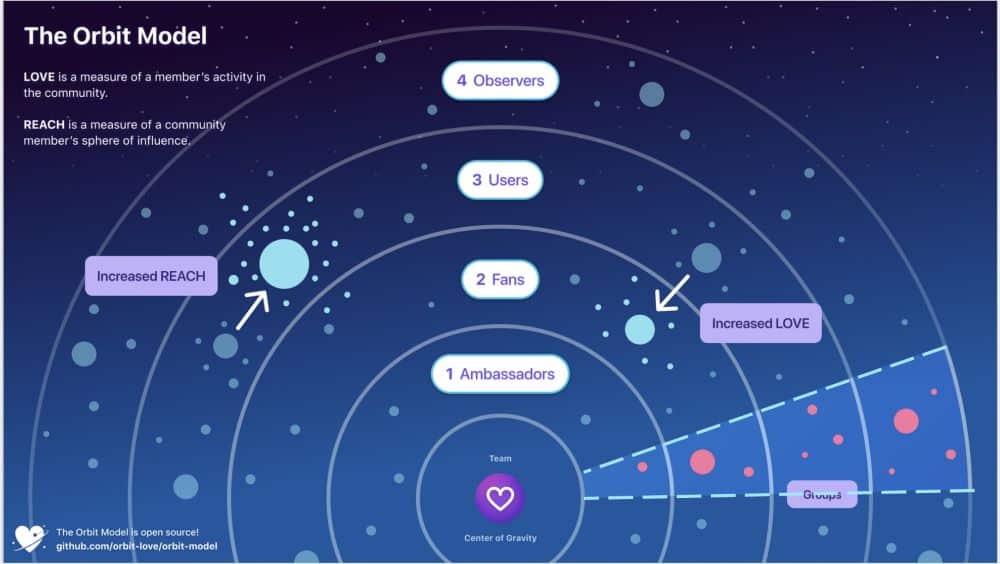

This is what we use to build in Google Analytics 4. Your online community managers and community builders will take part in the majority of this infrastructure. But it’s very important for marketers to be able to contextualise their funnel first.
Building community architecture in GA4
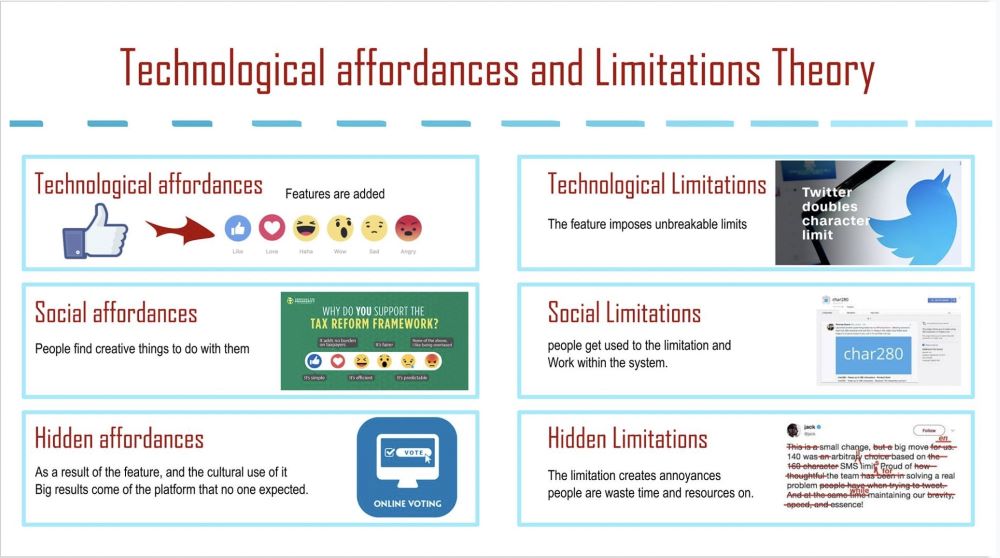
 We have heard in marketing that content is king, but we need to remember that context is Queen. That’s why need to talk about GA4 in the context of the technological affordances theory. In 2014 the community as a whole told Facebook that the like button was insufficient. We needed a better way of measuring our interactions with others.
We have heard in marketing that content is king, but we need to remember that context is Queen. That’s why need to talk about GA4 in the context of the technological affordances theory. In 2014 the community as a whole told Facebook that the like button was insufficient. We needed a better way of measuring our interactions with others.
In response, Facebook created five different emoji sets. They wanted us to increase the emotional responses of our communities. But we turned these emojis into a voting mechanism. Click ‘like’ for this, and click ‘wow’ for that. Suddenly the uses of emojis changed dramatically from their intended use. There’s this notion of hidden affordances.
When we build something technologically as GA4 has, the toolbox creates specific affordances and limitations in its use. UA had hidden limitations. GA4 provides affordances we are not yet aware of.
To do that, Google made a number of changes including:
- Dropping the funnel limitation. We no longer have to set up goals.
- Dropping the views in GA4. We no longer have directly limited data in each of our GA properties.
- Goals are no longer on data input. Our goals no longer have to be set up based on information coming in prior. We can now set that information on our website using Google Tag Manager (GTM). Then using GTM, we can play with the data as a completely open data lake within GA4.
- Google has added the events data format. GA4 can have 25 pieces of information (parameters) collected per event. This has created more feasibility for custom parameters.
- Google has given us a ‘tag and flag’ system that adapts all of our funnels to match unknown audience actions.
- Audiences are now more easily exportable. This allows us to understand the different audience demographics of our online communities.
The data toolbox is restricted in terms of available data. Where it fails to maintain user data it has made it easier for us to manage it. All of this is connected with a new paradigm: Google recognizes that, even though it is a giant, it needs other platforms to stand on its shoulders. Our CRMs, community intelligence platforms, and other data software suites have to be built on top of GA4.
This means that GA4 is no longer a data platform Think of an operating system — a kernel for us to build on top of.
Deep dive: GA4 infrastructure
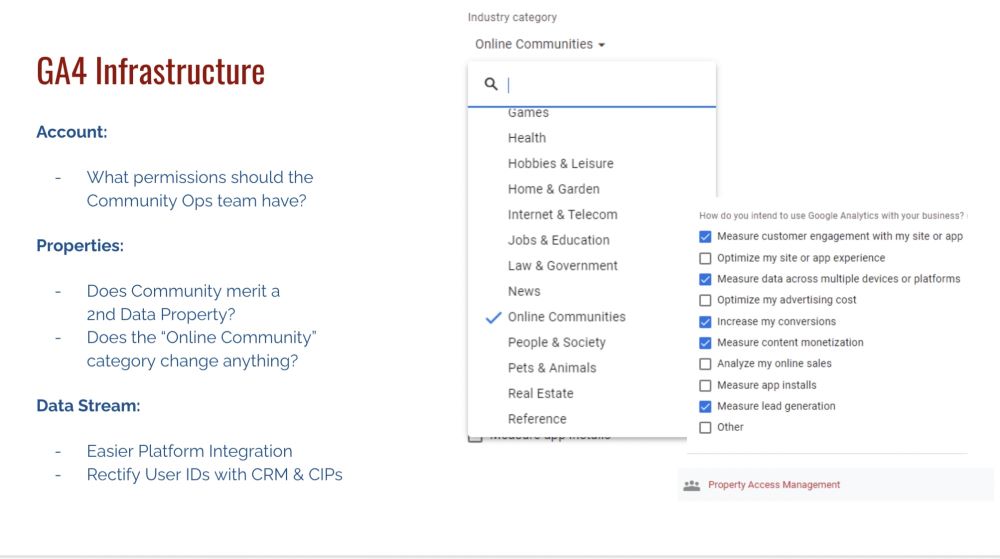
 When it comes to infrastructure in GA4, there are some key questions.
When it comes to infrastructure in GA4, there are some key questions.
The account level
What permissions should the community team have? Your community team will need access to GA4, but what level of access will you give?
A member of the marketing team will need to work directly under community operations. They have a say over how the team looks at data. But most importantly, your community team needs to have their hands on data, as it is now a social contract.
The properties level
Does your community merit a second data property? If you’re a bigger company, this is most likely the case. Otherwise, you may experience custom parameters and custom events conflicting with your website.
If you’re a small to medium-sized company, the answer is probably not. This is because your community is now a part of your funnel. Marketers have a social contract to measure the intentionality and connection and feedback of your wider community.
Note: You might notice an option labelled ‘Online Comunity’ in the Industry Category section. Currently, if you click this nothing changes in your property. However, it does give you new reports. It looks like Google is using the Industry category to deliver better customer reports. When setting up your property, it’s important to select the right category for your business.
The data stream level
For the infrastructure portion of your data stream, make sure that platform integration is front and centre. Work with your CRM and your community intelligence platforms on the user ID problem.
There are two issues with using user IDs for your personal portfolios and personal profiles. Firstly, it opens the door to security issues. Secondly, you’ll run into tech problems. You can turn on a lot of features within GA4 by rectifying the user ID issue. But you’ll need to be intentional about how you do it.
GA4 data flow
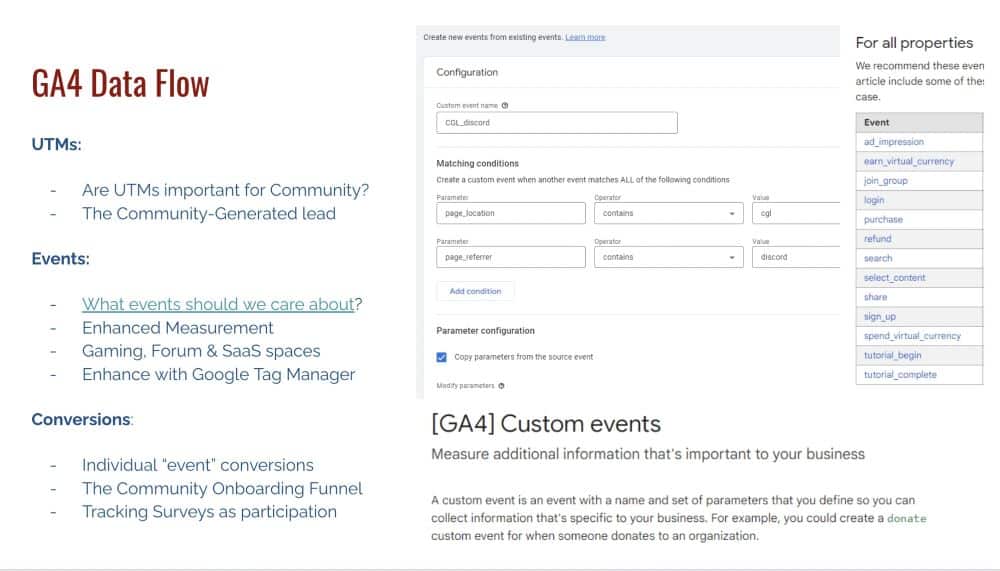
 Generally, in all data science there are three steps to filling your data repositories.
Generally, in all data science there are three steps to filling your data repositories.
- Bringing in the data.
- Storing the data.
- Massaging the data to report.
UTMs
UTMs are now more important in Google Analytics 4. This is because they are process focused rather than technology focused. We were originally using Urchin tracking modules and UTMs as a way of tagging content. But now they should be seen as a way of tagging processes.
We can add additional parameters to UTMs out of the box in GA4. This means that we can better organize how we talk with our larger community.
Events
GA4 is events based and we can create as many events as we want (within limits). This allows us to build events that are custom-made for our website and infrastructure.
One of the best aspects of events for marketers is that you can create a flag on your website for selected content interested in marketing. This can be pushed into GA4, allowing you to market your advertising to specific groups by user profile.
But you might be wondering, with all the functionality of GA4 events, what about Google Tag Manager? Using GTM is still strongly recommended. Remember that measurement is a muscle. If you’re at the beginning of your measurement journey, start with GA4. But you will want to move up to GTM eventually, the tool is much more capable and flexible.
Conversions
Events now have independent and retroactive conversion tagging. In UA, you had to set up individual goals. You would need to create a specific funnel flow, and at the end mark it as a goal. In GA4 this can be done for individual events. This means that you can put together as many onboarding, goal, or marketing funnels as needed.
Data processing
Audiences in GA4 are immensely powerful. By virtue of using the events system, events don’t just need to go to GA4. If you’re using GTM you can push them to your CRM, Facebook implementation, and more.
Because of that, you can now use your GA4 audiences to identify exactly who to contact. You can then configure how your community intelligence platform and your CRM will interact with your local community.
You could do this in UGA, but you needed entire reports to get the information you needed. Now, instead of having to create audiences over time, you can use GA4 to answer those questions much faster.
Side note: The community attribution problem

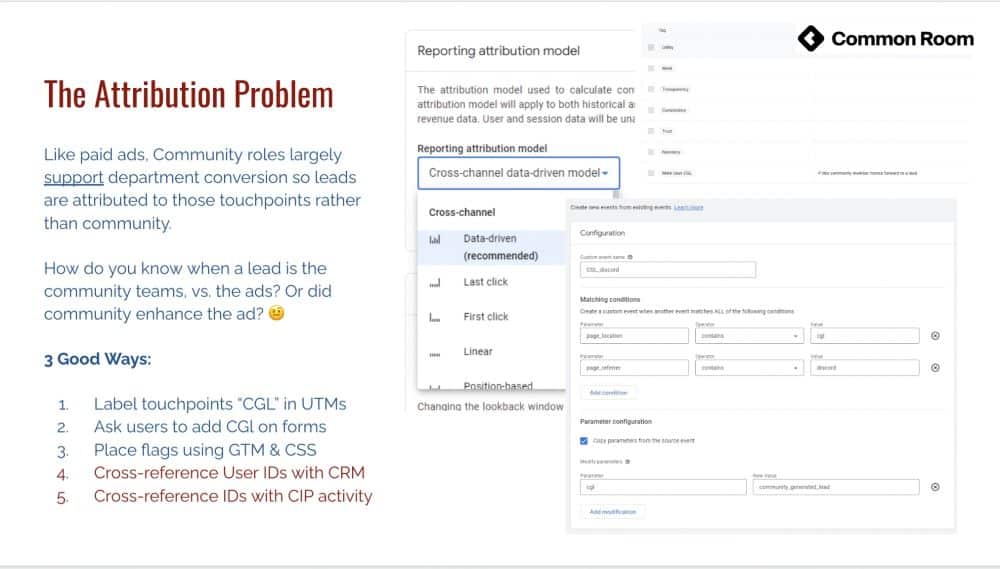
Has a community manager actually created a lead for your sales team? You can’t be sure when the lead also comes through your marketing funnel regularly. This is similar to the ads attribution problem.
You could reasonably just ask the lead ‘did you come from a community before you entered this funnel?’. You could also create a UTM tracking module for UTM source (the brand platform), UTM medium (community-generated lead), and UTM campaign (the product that a lead is for). But this option is difficult, you have to tag every link given in your community.
So how do you manage user attribution? One of the best things about GA4 is that user attribution is UI-powered and data-driven. But Google has also understood that this problem doesn’t just occur for paid ads. They accredited the entire attribution model for GA4 into the event path. You can now push your attributions as parameters into the events that you watch.
You can now answer the problem of ‘is this attributed to my sales team funnel, my community funnel, or both?’. By placing tags across your website, it can now be connected with user IDs. It can also attach tags to your CRM based on the development of that community.
It’s worth saying that the process of directly moving your GA4 and GTM data to a CIP/CRM can be highly complicated. But remember the technological affordances theory. GA4 has now given us a new toolbox that gives us new opportunities to learn about user attribution.
Plan big, progress small
We’ve talked about what’s helpful for Google Analytics 4, but that’s not necessarily what’s important here. Google has given us a technological toolbox and solutions, but in actuality, this is a cultural problem.
Firstly, how do we manage the safety, security, and anonymity of our users? Not only that, but we also need to ensure respect for the contributions of our online community. Users need to be able to stay in the valance of their chosen community until they want to move forward and shouldn’t be badgered about funnel steps that are not relevant.
But also, we still have marketing funnels that encourage users to move from the outer valances of our community scope to inner valances. This is a big process. So how do we go about completing it? You’ll need to make a number of changes within your business to facilitate using GA4 this way.

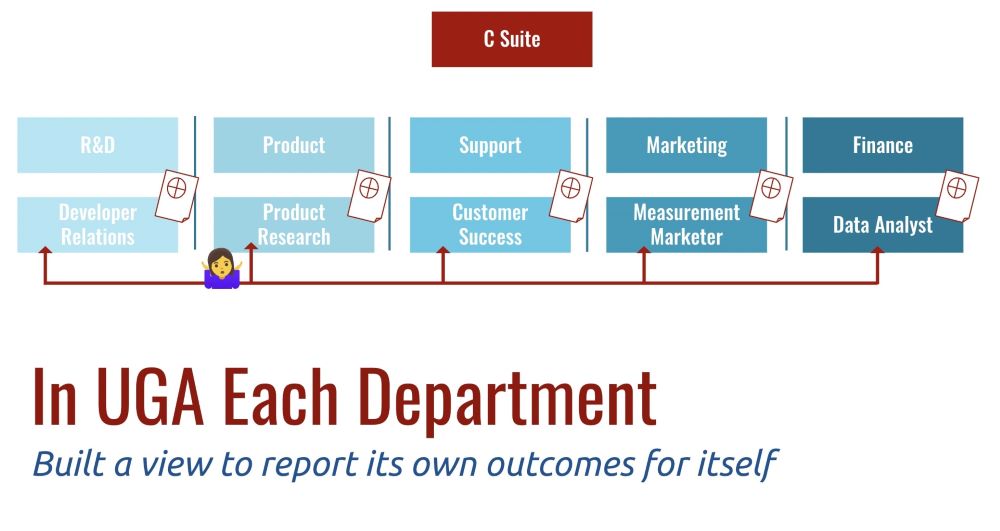
How we currently organize processes under UA
In UA this was the confounding struggle of reports in marketing and community managers. There was a conversation about where you should put your community manager, data analyst, and measurement marketer. These team members were put into departments, and each department had to report its own efficacy.
This caused a problem, departments had siloed themselves. R&D and developer relations had different reports from product research. The thought process behind this was that because their KPIs were different, they should have their own reporting process. That makes sense in a siloed top-down view of governance. This was a problem when individual team members were expected to collect information from all departments.
The new GA4 structure
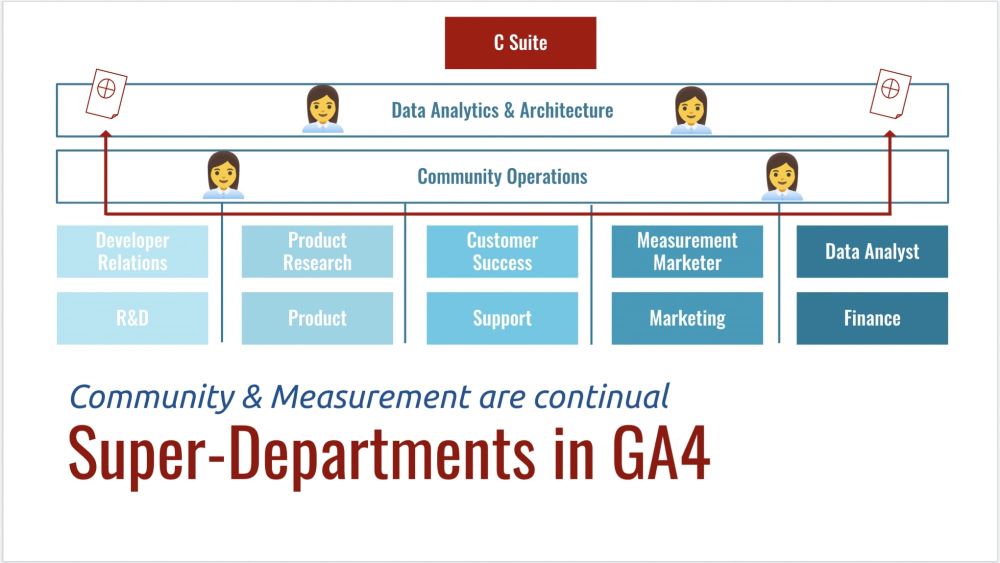
 With GA4 you need to recognize that measurement is no longer a project. It is now an oversight department. Your departments are actions at the end of your company. Departments exist for your community to interface with and find the person that they need.
With GA4 you need to recognize that measurement is no longer a project. It is now an oversight department. Your departments are actions at the end of your company. Departments exist for your community to interface with and find the person that they need.
Put your groups at the bottom of your setup, and the people working within these groups above, to simplify interactions. One member of each team should then report to two teams. Firstly, have a member within the community operations team. This means that each department is represented within the online community and reports on how the community impacted their touchpoints.
Then, the community operations team will escalate behaviours and sentiments to connect with all departments and create a super department of data analytics and architecture.
Together, with community and data analytics across departments, you can perpetually report over time – social-scientifically. This includes creating community scopes and building measurements.
By following this method you won’t be overloaded with reports. But also, you can build a ‘what’s in it for me’ setup because everyone has a say. Finally, you’ve also freed up your measurement marketers, your data analysts and your community operations teams.
This removes the issue of conflicting reports. There is only one cohesive team that connects with the C-suite.
Lastly: you need consistent cross-platform data
In GA4 cross-platform data is now extremely important. This is a hard problem to solve though, so to begin, focus on the one thing that each platform has in common: your website.
Make sure that your CSS class IDs make sense. Treat these as a cohesive naming convention that tells people the visual elements in each area of your site. Use them to trigger parameters in the data layer that exist on your end – not the users. By doing so, all the tools that you need can pull up the same event markups and parameters regardless of back-end integration issues.
And so, the rise of the community intelligence platform

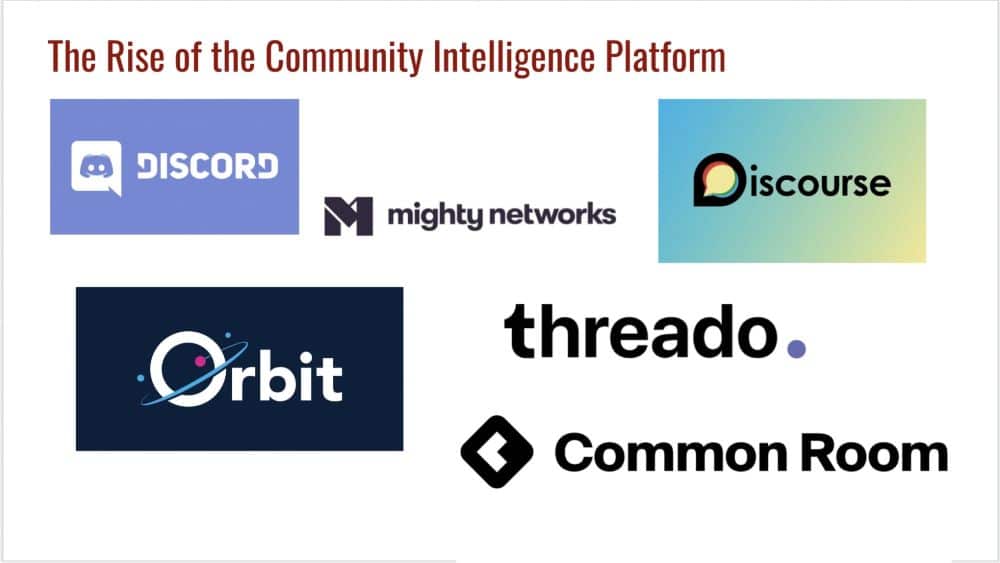
As a marketer, it’s worth looking into some of the community intelligence platforms with your community team. These platforms are reporting additional information so you can augment your GA4 systems via social scientific impacts. You can understand not just the behaviours your system trips, but the intent of those individuals’ actions. You can connect people’s comments in your communities with the behaviours in your funnels.
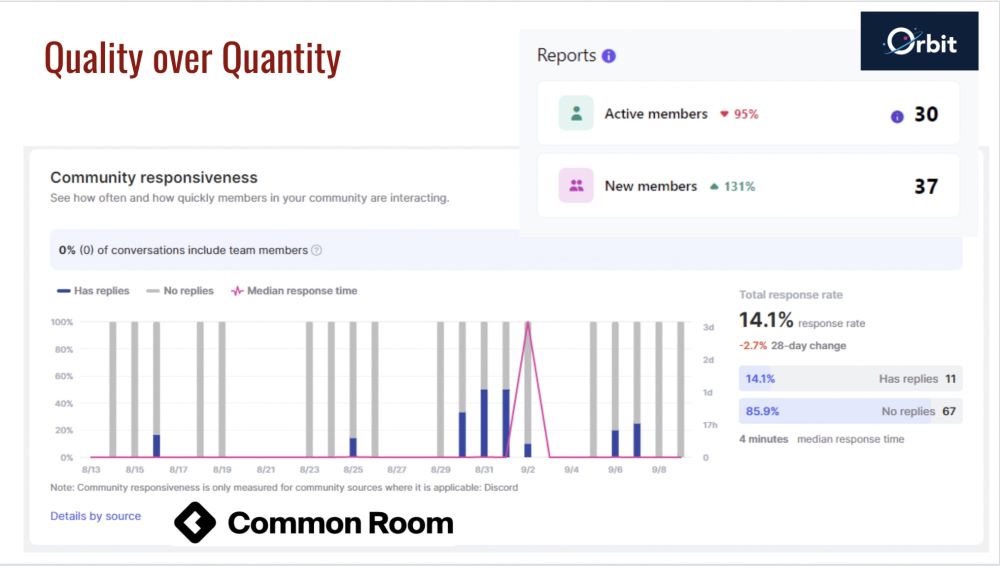

You can also start to pull in quantitative and qualitative data in order to better define what you’re looking at. You can look at your active and new members, but also how many people returned and why.
Wrapping up
So to conclude, we’ll leave you with this:
In 2013, Ryan Deiss said, ‘the one who spends the most to acquire their customers, wins.’
But now in 2023, it’s the people who spend the most time fostering their audiences that will grow most consistently.
Take your time cultivating your communities in GA4, and you’ll reap far more consistent rewards.
Further Reading
Want more? Check out our blog for tips on Google Analytics, GTM, and a whole host of other Google packages.
- How to Blend GA4 & UA Data Using BigQuery & Looker Studio - 12/07/2024
- How to do a Google Analytics 4 Audit & Mistakes to Avoid - 10/07/2024
- How to Backup & Visualize GA3 Data for Free - 27/06/2024